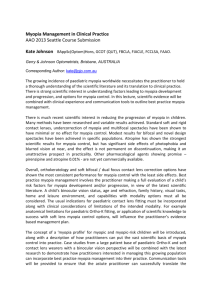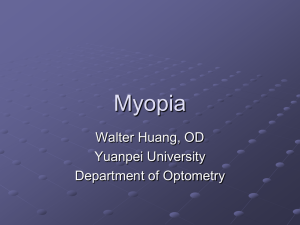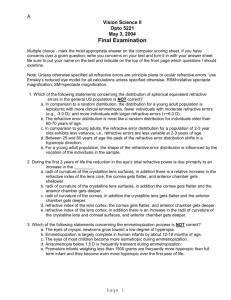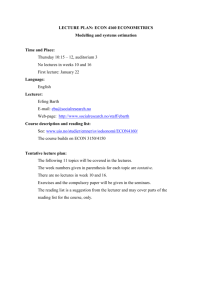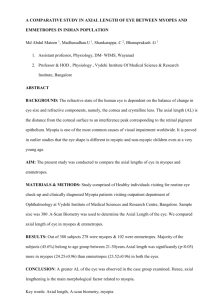5 Greene, Dynamic Eye Cycling
advertisement
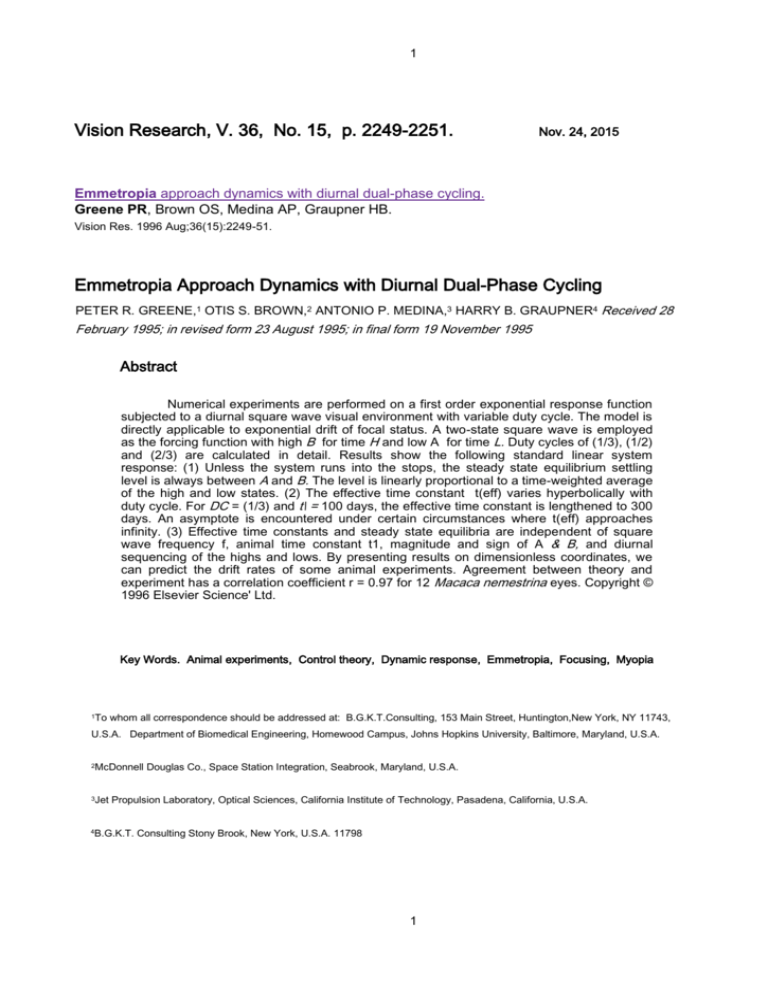
1 Vision Research, V. 36, No. 15, p. 2249-2251. Nov. 24, 2015 Emmetropia approach dynamics with diurnal dual-phase cycling. Greene PR, Brown OS, Medina AP, Graupner HB. Vision Res. 1996 Aug;36(15):2249-51. Emmetropia Approach Dynamics with Diurnal Dual-Phase Cycling PETER R. GREENE,1 OTIS S. BROWN,2 ANTONIO P. MEDINA,3 HARRY B. GRAUPNER4 Received 28 February 1995; in revised form 23 August 1995; in final form 19 November 1995 Abstract Numerical experiments are performed on a first order exponential response function subjected to a diurnal square wave visual environment with variable duty cycle. The model is directly applicable to exponential drift of focal status. A two-state square wave is employed as the forcing function with high B for time H and low A for time L. Duty cycles of (1/3), (1/2) and (2/3) are calculated in detail. Results show the following standard linear system response: (1) Unless the system runs into the stops, the steady state equilibrium settling level is always between A and B. The level is linearly proportional to a time-weighted average of the high and low states. (2) The effective time constant t(eff) varies hyperbolically with duty cycle. For DC = (1/3) and t\ = 100 days, the effective time constant is lengthened to 300 days. An asymptote is encountered under certain circumstances where t(eff) approaches infinity. (3) Effective time constants and steady state equilibria are independent of square wave frequency f, animal time constant t1, magnitude and sign of A & B, and diurnal sequencing of the highs and lows. By presenting results on dimensionless coordinates, we can predict the drift rates of some animal experiments. Agreement between theory and experiment has a correlation coefficient r = 0.97 for 12 Macaca nemestrina eyes. Copyright © 1996 Elsevier Science' Ltd. Key Words. Animal experiments, Control theory, Dynamic response, Emmetropia, Focusing, Myopia 1To whom all correspondence should be addressed at: B.G.K.T.Consulting, 153 Main Street, Huntington,New York, NY 11743, U.S.A. Department of Biomedical Engineering, Homewood Campus, Johns Hopkins University, Baltimore, Maryland, U.S.A. 2McDonnell 3Jet Douglas Co., Space Station Integration, Seabrook, Maryland, U.S.A. Propulsion Laboratory, Optical Sciences, California Institute of Technology, Pasadena, California, U.S.A. 4B.G.K.T. Consulting Stony Brook, New York, U.S.A. 11798 1 2 2 3 INTRODUCTION The visual phenomenon of emmetropization (i.e. approach to focused vision), myopia development, and hyperopia development are three seemingly different processes which can be modeled with control theory (Dorf, 1992; Brown & Berger, 1979; Greene & Guyton, 1986). Hyperopia may be a separate case entirely (Guyton et al., 1989), perhaps because the system is near the control limits or "stops". Young (1961) experimentally shows exponential approach to myopia with monkeys focusing at close range. Brown and Young (1981) use a standard first order exponential response function with good results. Medina (1987) fits ensemble data from 33,051 eyes with a second order response, i.e. exponential with cosine phase delay term. Ku and Greene (1981) apply variable duty cycle square waves. Raviola and Wiesel (1985) experimentally observe the exponential. Recent experimental work includes McBrien and Norton (1992), Smith, Hung and Harworth (1994), and the special issue in Vision Research "Myopia". All of the various theories assume 100% gazing at infinity, or 100% gazing at some intermediate distance. However, the average human does not spend 100% of the time focused at the same distance. Instead, a certain percentage of the day is spent, at T.V. distance, another percentage at book distance, another percentage at blackboard distance, etc. Likewise, and approximately equivalent from the optics point of view,, when reading or watching T.V., the individual may or may not use glasses, etc. Thus, given the distance, the power of the lenses, and the time spent in the equivalent optical environment specifies an integral which is the net optical impulse of the environmental effects. There is uncertainty about the eye's behaviour during sleep, although several reports help with this concern. Various aspects of control theory, accommodation, convergence, and dark focus are discussed by Fincham (1962), Leibowitz and Owens (1975), Hung and Semmlow (1980), and Owens and Higgins (1983). Results presented here are non-dimensional so that different time constants can be appreciated. For instance, Schaeffel et al. (1988) and Wallman et at. (1978) show that chickens have a fast time constant, in the order of 20-30 days, over which time 10 diopter changes in myopia or hyperopia occur. Goss and Criswell (1981) summarize animal experiments as they apply to ametropia. Depending on environmental conditions, changes can occur in either the myopic or hyperopic direction. Medina and Fariza (1993) show 1-2 year effective time constants for some human subjects. In this report, rather than dealing with the complications of several different environmental input levels, just two are used, low level A and high level B, with variable duty cycle being the parameter of interest [see Fig. 2(a) and (b)]. The results probably can be generalized to three or more environments, but we have not tried that yet. The highs and lows of the diurnal cycle can be thought of as the nears and fars of the environment. 49 3 4 4 5 MATERIALS AND METHODS As per Brown and Berger (1979) and Greene and Guyton (1986), we employ here a simple first order exponential to model the refractive drift of the optical system over time when the effective optical environment changes: R(t) = B - (B - A) * [1 - exp( -t/t1 ) ] (1) Here, R(t) is the effective refractive state of the visual system, B is the refractive state at time t < 0, and A is the new equivalent visual environment to which the system is exposed, step-wise, at t = 0. Animal time constant fl is taken to be a nominal 100 days, as supported by the experiments of Young (1961), Brown and Young (1981), Raviola and Wiesel (1985), and Greene and Guyton (1986). As shown in Fig. 1(b), this control system will respond with a decaying sawtooth when the environment is applied as a variable percentage square wave. The "high" phase of the square wave is denoted Phase I, and the "low" phase is denoted Phase II. We use the following basic iterative equations during these phases: Phase I: R(t) = R1(t1) [ Rl (ti) - A] * [ l – exp (- t/t1 ) ] (2) Phase II: R(t) = R2 ( tj ) [B - R2 ( tj ) ] * [ l - exp( -t / tl ) ] (3) where [ tj = ( ti + 1 ) ]. Then, to complete the iterative recursion procedure, we advance to the next time increment with boundary and initial conditions: (4) B.C. I.C. Rl = R2 t=0. 5 6 6 7 RESULTS AND DISCUSSION Figure 2(a) shows the strong effect duty cycle has on the effective time constant of the system. Figure 2(b) shows that the equilibrium settling level is simply a time-weighted average of the highs and lows of the applied square wave environment. Figure 3, with animal data from Young (1961) arid a time constant t\ of 100 days, correlates at the level r = 0.97 for 12 age matched Macaca nemestrina eyes from six adolescent monkeys. Theory agrees with experiment plus or minus 0.06 diopters, i.e. with greater accuracy than one can currently measure experimentally. Thus, we say with confidence the drift dynamics are exponential. Applications As a practical example of these equations, say you are observing a 4 diopter refractive state R(t) subjected to a 3D and 4D square wave visual environment with duty cycle of (1/3). With a normal time constant of 100 days, this system will take approx. 300 days to reach the (1/e) point, hence the origin of the effective time constant. With a re-scaling of the system boundary conditions, based on the time-weighted average of the applied environment, the time constant re-scales to 100 days. Independent of duty cycle, an exponential response always results. Time constant is always preserved. But, as a practical matter, the system takes longer to influence with low impulse cycles. In terms of practical real-time applications, notice that 4-6 h per day one way or the other, i.e. a fraction of one duty cycle, can make the difference between 1 year and 3 years in terms of achieving an objective level. Ku and Greene (1981) present similar time-weighted average results appropriate during the initial dynamic stage (i.e. t < to) for variable duty cycle loading of rabbit eyes; in this case, theory and experiment agree with correlation r = 0.91. Focusing during sleep is a matter of experimental interest. Events during the night are not known. We can assume, based on preliminary experiments (see Introduction), that the eye resorts to a compensatory offset, or "dark focus" value of 0.5 D of hyperopic reserve. The net optical impulse of the sleep cycle should approximately balance the environmental impulse accumulated during the waking hours to maintain steady state level. If this is not the case, theory predicts that R(t) will drift to a new level. In the absence of experimental data while the subject is unconscious, we can invent a Conservation of Impulse law to indirectly subsume the night time activities. Results presented here are sufficiently general to accept any level . Note added after proof. Another practical application of this mathematical model is predicting the effect of bifocal or progressive addition lenses ( PALs ) on the progression rate of myopia. In this case, the difference between the near field ( A diopt.) and far field ( B diopt. ) values of the environment are reduced in magnitude by approximately 2 diopters, the value of the ( + ) reading Add in the lower segment of the frame. Theory predicts this should slow the rate of myopia progression [12] [19]. General results Effective time constants and steady state equilibrium levels are independent of square wave frequency /, animal time constant fl, magnitude and sign of the high and low states A and B, and even random diurnal sequencing of the highs and lows. Presenting results on dimensionless coordinates allows prediction of different animals with different time constants in variable environments. In general, the observed and calculated diopter drift dynamics are consistent with standard control theory and first order linear system response. 7 8 8 9 9 10 REFERENCES [ n.b. – References are in Pub Med format. Click on Title to view Abstract (and Article) ] 1. Brown, O. S. & Berger, R. (1979). A nearsightedness computer. Proceedings N. E. Bioengineering, 7, 343-346. 2. Brown OS, Young FA. The response of a servo controlled eye to a confined visual environment. Rocky Mountain Bioengineering Conference, 18, 41-44. Biomed Sci Instrum. 1981;17:41-4. 3. Dorf, R. C. (1992). Modern Control Systems (717 pp). New York: Addison-Wesley. 4. Fincham, E. F. (1962). Accommodation and convergence in the absence of retinal images. Vision Research, 1, 425-440. 5. Goss DA, Criswell MH. Myopia development in experimental animals-a literature review. Am J Optom Physiol Opt. 1981 Oct;58(10):859-69. 6. Greene PR, Guyton DL.Time course of rhesus lid-suture myopia. Exp Eye Res. 1986 Jun;42(6):529-34. 7. Guyton DL, Greene PR, Scholz RT. Dark-rearing interference with emmetropization in the rhesus monkey. Invest Ophthalmol Vis Sci. 1989 Apr;30(4):761-4. 8. Hung GK, Semmlow JL. Static behavior of accommodation and vergence: computer simulation of an interactive dual-feedback system. IEEE Trans Biomed Eng. 1980 Aug;27(8):439-47. 9. Ku DN, Greene PR. Scleral creep in vitro resulting from cyclic pressure pulses: applications to myopia. Am J Optom Physiol Opt. 1981 Jul;58(7):528-35. 10. Leibowitz HW, Owens DA. Anomalous myopias and the intermediate dark focus of accommodation. Science. 1975 Aug 22;189(4203):646-8. 11. McBrien NA, Norton TT. The development of experimental myopia and ocular component dimensions in monocularly lid-sutured tree shrews (Tupaia belangeri) Vision Res. 1992 May;32(5):843-52. 12. Medina A. A model for emmetropization: predicting the progression of ametropia. Ophthalmologica. 1987;194(23):133-9. 13. Medina A, Fariza E. Emmetropization as a first-order feedback system. Vision Res. 1993 Jan;33(1):21-6. 14. Owens RL, Higgins KE. Long-term stability of the dark focus of accommodation. Am J Optom Physiol Opt. 1983 Jan;60(1):32-8. 15. Raviola E, Wiesel TN. An animal model of myopia. N Engl J Med. 1985 Jun 20;312(25):1609-15. 16. Schaeffel F, Glasser A, Howland HC. Accommodation, refractive error and eye growth in chickens. Vision Res. 1988;28(5):639-57. 17. Smith EL 3rd, Hung LF, Harwerth RS. Effects of optically induced blur on the refractive status of young monkeys. Vision Res. 1994 Feb;34(3):293-301. 18. Wallman J, Turkel J, Trachtman J. Extreme myopia produced by modest change in early visual experience. Science. 1978 Sep 29;201(4362):1249-51. 19. YOUNG FA. The effect of restricted visual space on the primate eye. Am J Ophthalmol. 1961 Nov;52:799-806. 20. Special issue Myopia. (1995). Vision Research, 3519. 21. Acknowledgement—This work was supported in part by NIH/NEI Research Grant EY-05013. End of Word File 10 11 / 24 / 2015 11 11
